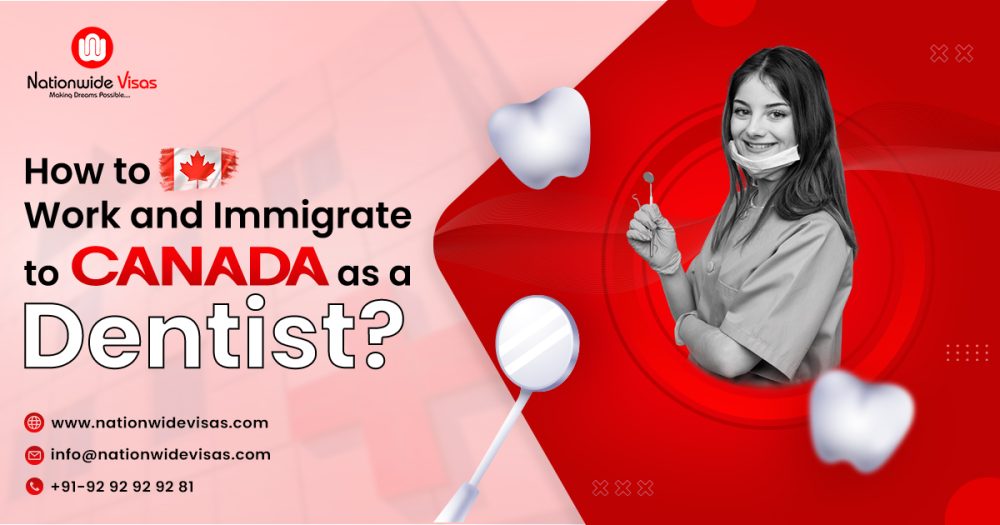If you’re a dentist trying to figure out if your skills are in demand overseas, here’s a short response: yes, and Canada would be the happy place for such a wish.
Picture this: a bustling dental practice, modern equipment, a waiting list full of patients and a country that not only appreciates your work but also has a very clear pathway to apply for Canada PR. Sounds good? Let’s break it down exactly how you get to have that in 2025.
Why Canada Needs Dentists
Canada has a shortfall in healthcare professionals and dentists are again included in this list. Many of the communities, particularly small cities and rural populations, are severely lacking professionals to meet the needs of the populations. Patients wait weeks or months before they get appointments, and clinics are extremely eager to hire foreign dentists.
Here are a few reasons why the right time to plan your move is 2025:
- Dentists are in demand: There are continuous job postings across provinces and territories.
- Great earning potential: Average salaries range between CAD 120,000 and 200,000, much more for those in specialization.
- Strong immigration support: Targeted Express Entry draws for healthcare workers are now common.
- Work-life balance: Modern dental practices with advanced technology and a supportive healthcare system.
Step by Step Guide
Step 1: Get your License to Practice
Get your license before looking into job opportunities. Dentistry is regulated in Canada so that it would be impossible for you to practice without showing that you meet British professional standards.
This is the part where the National Dental Examining Board of Canada (NDEB) comes into effect. In general, the process goes like this: you submit your degree and documents for credential verification, followed by a series of exams including written tests, clinical judgment assessments, and hands-on evaluations.
Intense, as it sounds, and many internationally trained dentists take bridging programs at Canadian universities to prepare. These serve to fill knowledge gaps, give you information about the Canadian standards, and increase your chances of passing the NDEB on your first try.
Once you have passed, you can register with the provincial dental authority where you wish to work, and just like that, you’re free to practice legally.
Step Two: Get Permanent Residency
Now, let’s put some clear terms about the visa you’ll need to actually be living and working in Canada. The good news is that Canada’s immigration system really does encourage healthcare professionals to apply.
The most famous route is Express Entry, which ranks applicants by awarding points for age, educational qualifications, and work experience, among others. Based on your Comprehensive Ranking System (CRS) points, additional marks for the IELTS score are added. Canada has been having draws focusing on healthcare. This further improves dentists’ chances of receiving invitations for PR applications.
If you’re around the low range of scores, then just cool; Provincial Nominee Programs (PNPs) are almost always there. There are provinces such as Ontario, British Columbia, and Saskatchewan that invite healthcare professionals under their immigration streams. A provincial nomination adds 600 points to your CRS score, almost guaranteeing you a PR invitation.
Step Three: Ensure your eligibility.
Before starting this process, check some basics first: a dental degree recognized, an Educational Credential Assessment (ECA) to prove it, and an IELTS General score of at least CLB 7 or higher. You have to have at least one paid, full-time year as a dentist, and you should also have enough savings to keep you fed during those first days of transition settling in Canada.
There will also be a medical exam and police clearance required of all PR applicants-so add that paperwork to your “Things to Prepare” list.
Step Four: Start the Job Search
You can start applying for jobs immediately (actually, as soon as you’re licensed or while you’re in the process). For that, the Job Bank Canada is going to be a great place to start looking; don’t forget to do a search at the same time on LinkedIn, Indeed, and provincial health job boards.
Rural communities usually have a greater need for dentists and may commit to providing incentives such as relocation support and signing bonuses. This could be a great way to begin your career in Canada, gain experience, and reputation in the local job market.
Be Prepared for the Challenges
Let’s be realistic. Nothing comes easy. The NDEB process takes time, and most importantly, it requires a serious amount of preparation. Bridging programs range between CAD 30,000 and 50,000; finding a suitable job within a competitive city might take longer than you expect.
But look at it as an investment. Once you settle down, you’ll earn a competitive salary, twist and turn at advanced technology, and enjoy a balanced lifestyle.
Why You Might Need Professional Help
Managing the NDEB exams, PR paperwork, job search, and deadlines can feel overwhelming.
That’s what makes Top Immigration Consultant in India a real game-changer. They will:
- Direct you to the right immigration program.
- Help you in raising your CRS score.
- Get the entire PR application paperwork done.
- Guide you through licensing requirements and possibly offer job search strategies.
Having expert support can save you from costly mistakes and make the entire process faster and smoother.
Final thoughts.
Dentistry is a highly valued profession in Canada… as indeed the country would be keen on attracting skilled professionals into its fold in 2025. Clear licensing procedures, numerous immigration routes, and great demand for dental services make the pipeline as easy as it gets now.
If you’ve ever been thinking about taking your dental career abroad, there can’t be a better time than now to move to Canada as a dentist. With high demand, clear PR pathways, and reasonable earning potential, Canada is the ultimate destination for dental professionals.
